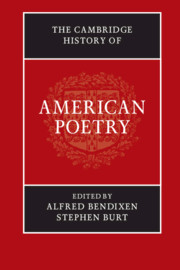Book contents
- The Cambridge History of American Poetry
- The Cambridge History of American Poetry
- Copyright page
- Contents
- Notes on Contributors
- Acknowledgments
- Introduction
- Part I Beginnings: Poetry before 1800
- Part II A New Nation: Poetry from 1800 to 1900
- Part III Forms of Modernism, 1900–1950
- Chapter 22 The Twentieth Century Begins
- Chapter 23 Robert Frost and Tradition
- Chapter 24 T. S. Eliot
- Chapter 25 William Carlos Williams
- Chapter 26 Finding “Only Words” Mysterious
- Chapter 27 Marianne Moore and the Printed Page
- Chapter 28 The Formalist Modernism of Edna St. Vincent Millay, Helene Johnson, and Louise Bogan
- Chapter 29 The Romantic and Anti-Romantic in the Poetry of Wallace Stevens
- Chapter 30 Ezra Pound, William Carlos Williams, and the East Coast Projectivists
- Chapter 31 Langston Hughes and His World
- Chapter 32 The Objectivists and the Left
- Chapter 33 “All the Blessings of This Consuming Chance”
- Chapter 34 Elizabeth Bishop, Randall Jarrell, and the Lost World of Real Feeling
- Chapter 35 Writing the South
- Part IV Beyond Modernism: American Poetry, 1950–2000
- Selected Bibliographies
- Index
Chapter 22 - The Twentieth Century Begins
from Part III - Forms of Modernism, 1900–1950
Published online by Cambridge University Press: 05 December 2014
- The Cambridge History of American Poetry
- The Cambridge History of American Poetry
- Copyright page
- Contents
- Notes on Contributors
- Acknowledgments
- Introduction
- Part I Beginnings: Poetry before 1800
- Part II A New Nation: Poetry from 1800 to 1900
- Part III Forms of Modernism, 1900–1950
- Chapter 22 The Twentieth Century Begins
- Chapter 23 Robert Frost and Tradition
- Chapter 24 T. S. Eliot
- Chapter 25 William Carlos Williams
- Chapter 26 Finding “Only Words” Mysterious
- Chapter 27 Marianne Moore and the Printed Page
- Chapter 28 The Formalist Modernism of Edna St. Vincent Millay, Helene Johnson, and Louise Bogan
- Chapter 29 The Romantic and Anti-Romantic in the Poetry of Wallace Stevens
- Chapter 30 Ezra Pound, William Carlos Williams, and the East Coast Projectivists
- Chapter 31 Langston Hughes and His World
- Chapter 32 The Objectivists and the Left
- Chapter 33 “All the Blessings of This Consuming Chance”
- Chapter 34 Elizabeth Bishop, Randall Jarrell, and the Lost World of Real Feeling
- Chapter 35 Writing the South
- Part IV Beyond Modernism: American Poetry, 1950–2000
- Selected Bibliographies
- Index
Summary
Keywords
- Type
- Chapter
- Information
- The Cambridge History of American Poetry , pp. 497 - 518Publisher: Cambridge University PressPrint publication year: 2014



